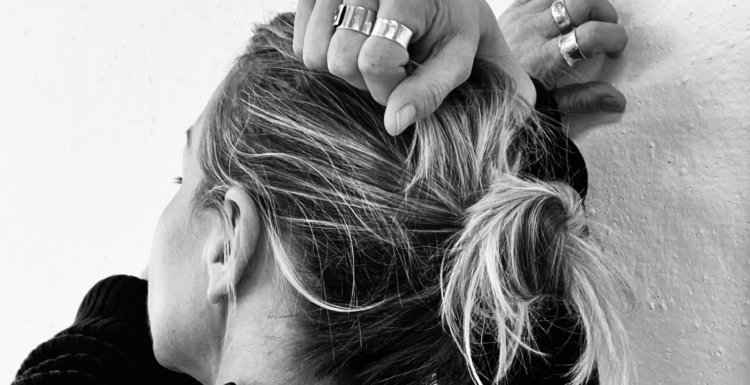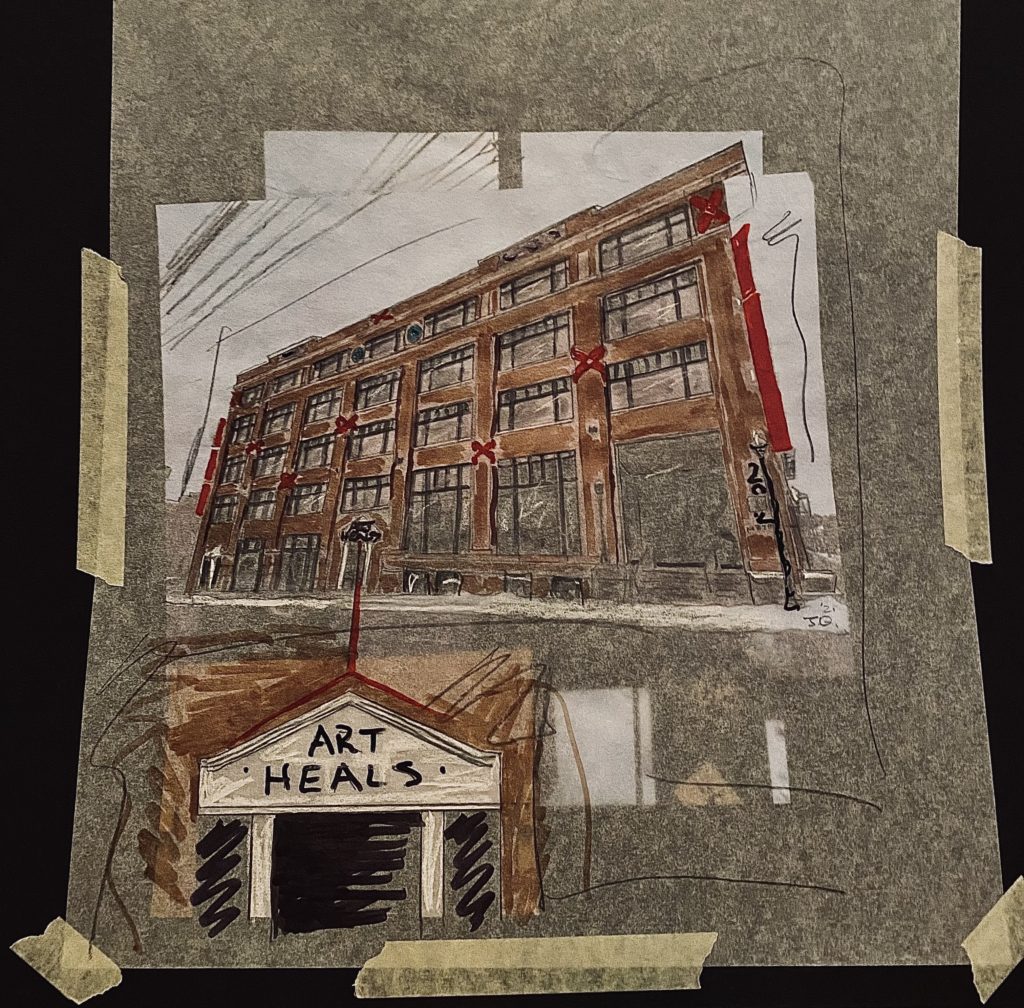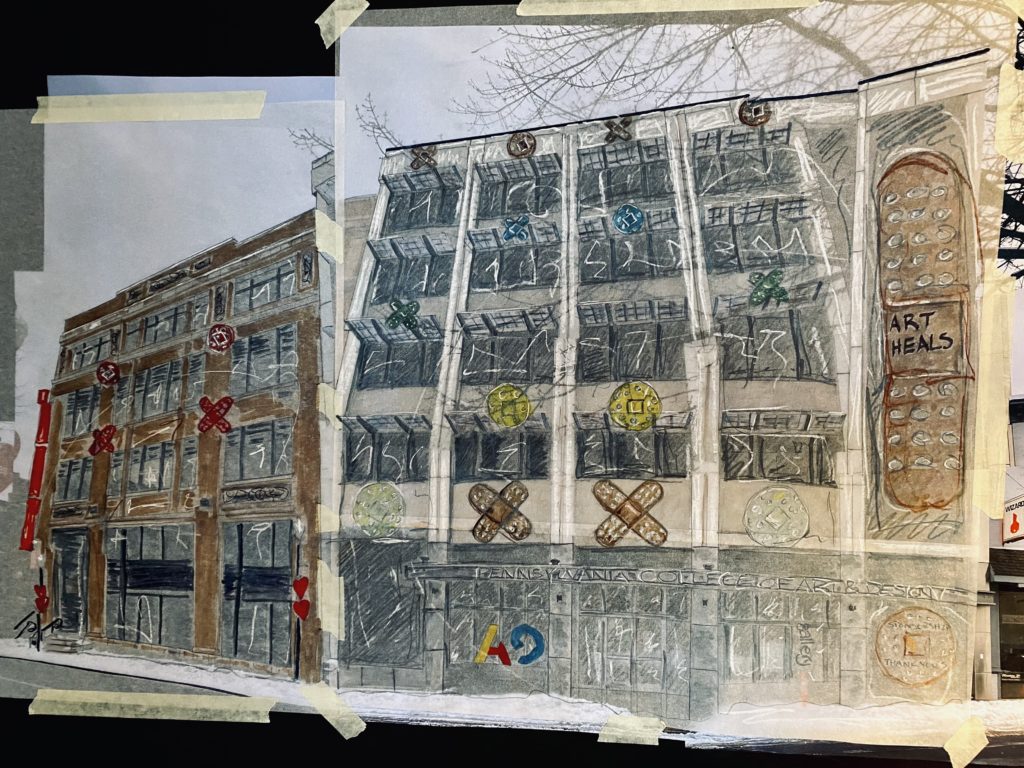
PCA&D’s unveiling of Art Heals, with Artist in Residence Jennifer Quigley, set for June First Friday
Wednesday, May 19th, 2021
In her sun-filled fourth-floor studio at Pennsylvania College of Art & Design, artist Jennifer Quigley stands back and examines a 3D bandage leaning against the wall.
About 3 feet across, the “X”-shaped Band-Aid-style is a smaller version of those that will be mounted on the facade of the College in June. Across Prince Street, in the Art Garden, sculptural bandages and wrappers, some large enough to sit on, will expand the large-scale public art installation out into the community itself, sharing a cohesive message:
Art is more than something to look at. It evokes passions like activism, it calms, it inspires, it instructs.
And art heals.
Quigley, a locally based artist whose work runs the gamut from painting and photography to sculpture and mixed media, is a psychotherapist who’s also certified in expressive arts therapy. She’s the first Artist in Residence for the College’s Healing Arts Residency, an initiative of PCA&D’s Institute of Learning, Creative Entrepreneurship, and Innovation. That institute currently is collaborating with the local medical and art communities to inspire creative practices that promote community healing, wellness, coping, and personal growth.
Another benefit: It exposes students to the career possibilities available when the fields of art and health are combined.
“Healing Arts offers a wide array of career choices spanning diverse communities, settings, and populations,” says Todd Snovel, PCA&D’s Director of Development and Strategic Initiatives. The College, he says, is “centered in developing innovative pathways for students to consider projects and job opportunities within evolving creative arts.”

Preliminary draft by artist Jennifer Quigley of the Art Heals installation on PCA&D’s Chestnut Street facade.
Expressive Art Therapy
So what, Quigley’s asked, is “expressive art therapy?”
In a nutshell, she says, it’s a process that incorporates numerous creative approaches — music, art, dance, and play therapies, for example — that are blended to suit a client’s needs.
“What’s really important,” she says, “is that the arts are respected as much as the therapy in the process.
“PCA&D is a wonderful incubator for developing a program with that much artistic and therapeutic ethos.”
Artist Statement: Jennifer Quigley, MA, LPC, REAT
Art processes my pain
It’s my therapist
My physician
My clergy
My friend’s ear at 4am
It’s mom putting a Band-Aid on my knee after falling off my bike
Through this exhibit
I extend that comfort to you.
Credentialed as a licensed professional counselor and as a Registered Expressive Arts Therapist, Quigley maintains a practice in Lancaster and has studied with some of expressive arts therapy’s most influential minds, such as Shaun McNiff and Pat Allan.
Some of her art is inextricably tied to music, from collaging the facade of a Detroit building in Rolling Stone covers (a project that was, appropriately enough, then featured in Rolling Stone), to Guitars & Cadillacs, a joint exhibition near Nashville that featured her guitar sculptures alongside the photography of country music legend Marty Stuart.
“I’m a large-scale thinker,” Quigley says, “all the way back to my elementary school projects filling the back of the station wagon!”
Unveiling June 4
That made her a great fit for this kickoff public art project undertaken by the College’s Healing Arts program. Funded by a passion grant from the Lancaster County Community Foundation, Quigley’s vision officially will be unveiled to the public on June 4, to mark June’s First Friday celebrations in downtown Lancaster.
Because of COVID health and safety restrictions, much of the project’s early days had to be coordinated virtually, Quigley said, and the project only really began to take off in February or March. Fortunately, she says, “I’m a timeline person — I know how to choreograph how (projects) need to flow.”
Lately, that’s involved trips to ATOMIC, a locally-based company that builds environments for live events worldwide. There, she’s been meeting with Atomic artists who are fabricating her bandage concept so it can withstand long-term outdoor display; determining how the work can be illuminated, calculating the correct scale so that the artwork can be seen (without overwhelming the budget); and, she says, “going into a huge exploratory process of what materials would be best.”
Within weeks, Quigley’s work will be installed across the facade of campus on the west, south, and east sides of the buildings. Across the street, the PCA&D ampersand, still bearing a collage installed by local artists during last summer’s Black Lives Matter demonstrations, will be joined by carefully placed 3D works of Quigley also tied to the Healing Arts exhibition.

